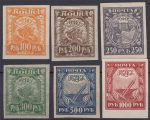The first postage stamps of Soviet Russia were issued in November 1918, celebrating the first anniversary of the establishment of the Russian Soviet Federated Socialist Republic. The set of two stamps (35 and 70 kopecks) were prepared by Provisional government, but were approved and issued under Russian Soviet Federative Socialist Republic authority.
The first definitive series of the RSFSR was issued in 1921. It included five designs of new Soviet symbols such as agricultural labour, industrial labour, science and arts, hammer and sickle, and freed proletarian.
The first regular issue involved eleven different stamps of denominations ranging between 1 and 1,000 rubles. Among these, five stamps showed the agricultural-labour design, printed in different colours and with face values of 1, 2, 100, 200, and 300 rubles. The industrial-labour symbol was given in three denominations: 5, 500, and 1,000 rubles. The stamp for science-and-arts appeared only once. To a certain degree, designs of the series, focusing more on agriculture and industry, were in conformity with the spirit of the government’s New Economic Policy of 1921 aimed at recovering the RSFSR economy. They also followed the same vogue that could be found in Soviet poster art in 1921, when the Soviet government, “having secured its own position, turns to problems of peaceful social and economic development (economic and cultural themes move rapidly to the fore).”
Reflecting new political goals, RSFSR postage stamps provided visual messages of the values and major social groups within Soviet society. Portraying the three social groups, the RSFSR’s final definitive issues in 1922 and 1923 depicted the worker, the soldier, and the peasant that constituted the Soviet state. These were stylistic representations in the form of classical busts resembling portraits of monarchs and other heads of state on stamps of other countries.
Replacing the portraits of the tsars, depiction of the three social groups was on purpose, because the Soviet government “specifically decided to create images which would symbolise the idea of worker-peasant power.” The sculptor Ivan Shadr was author of these images. Designing the busts, he created the worker first, then the Red Army soldier. These two stamps appeared in December 1922. The stamp showing the bust of the peasant came out five months later, in May 1923. Among the eleven denominations of the fourth definitive issue, the worker appeared on stamps three times, the soldier six times, and the peasant showed up on two stamps.
| Issue | Years | Catalog numbers | |
 |
First issue | 1918 | 1-2 |
 |
Reprint of 1908-1917 | 1918-1919 | R1-R2 |
 |
Reprint of 1917 | 1919 | R3-R5 |
 |
August definitive issue | 1921 | 3-7 |
 |
August-September definitive issue | 1921 | 8-13 |
| Fourth Anniversary of the October Revolution. | 1921 | 14-17 | |
 |
Volga Famine Relief Issue. December 1921 | 1921 | 18-21 |
 |
Volga Famine Relief Issue. January 1922 | 1922 | 22-27 |
 |
Definitive Overprint Issue. February 1922 | 1922 | 28-39 |
 |
March-April 1922 | 1922 | 40-44 |
| To be continued… | |||